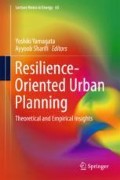Abstract
The Resilience Matrix is a framework for the performance assessment of integrated complex systems. This chapter reviews the development of the matrix then describes two case studies and discusses lessons learned. The structure is a 4 × 4 matrix; the rows describe the four general management domains of any complex system (physical, information, cognitive, social) as described in the US Army’s Network-Centric Warfare doctrine and the columns describe the four stages of disaster management (plan/prepare, absorb/withstand, recover, adapt) as defined by the US National Academy of Sciences in their definition of disaster resilience. Collectively, these sixteen cells provide a general description of the functionality of a system through an adverse event. The matrix serves as an organizing framework for a screening-level assessment of the resilience of a system with respect to each critical service it provides. Indicators linked to each cell can be used to describe system performance and identify areas for further investigation. Additionally, the matrix framework can be used to organize the many government agencies and community institutions across different spatial scales that contribute to the operation of each critical service. In this way the matrix serves as a tool to initiate resilience planning and coordination, address jurisdictional issues, and identify gaps in the various roles and responsibilities for complex urban systems where human performance and decision making plays a critical role. The case studies described here (Rockaway, New York City and Mobile, Alabama, USA) are focused on coastal community resilience in the face of storm surge and flooding; however, the lessons learned speak to the broader contribution of the resilience matrix to the fields of risk assessment and urban planning.
Access this chapter
Tax calculation will be finalised at checkout
Purchases are for personal use only
References
Alberts DS, Hayes RE (2003) Power to the edge: command… control… in the information age. Office of the Assistant Secretary of Defense Washington DC Command and Control Research Program (CCRP). Retrieved from http://www.dodccrp.org/files/Alberts_Power.pdf
Arnold JL (1988) The evolution of the 1936 flood control act. Office of History, US Army Corps of Engineers
Bakkensen LA, Fox‐Lent C, Read LK, Linkov I (2016) Validating resilience and vulnerability indices in the context of natural disasters. Risk Anal
Blake ES, Kimberlain TB, Berg RJ, Cangialosi JP, Beven JL II (2013) Tropical cyclone report hurricane sandy (AL182012) 22–29 October 2012. National Hurricane Center. 12 Feb 2013. Accessed 19 June 2017 at http://www.nhc.noaa.gov/data/tcr/AL182012_Sandy.pdf
Bruneau M (2006) Enhancing the resilience of communities against extreme events from an earthquake engineering perspective. J Secur Educ 1:159–167. https://doi.org/10.1300/J460v01n04_14
Cutter SL et al (2013) Disaster resilience: a national imperative. Environ Sci Policy Sustain Develop 55(2):25–29
Eisenberg DA, Park J, Bates ME, Fox-Lent C, Seager TP, Linkov I (2014) Resilience metrics: lessons from military doctrines. Solutions 5(5):76–87
European Commission (2016) Resilience. In: European civil protection and humanitarian aid operations. http://ec.europa.eu/echo/what/humanitarian-aid/resilience_en. Updated 6 Aug 2016. Accessed 19 June 2017
Fox-Lent C, Bates ME, Linkov I (2015) A matrix approach to community resilience assessment: an illustrative case at Rockaway Peninsula. Environ Sys Decisions 35(2):209–218
Linkov I, Moberg E (2011) Multi-criteria decision analysis: environmental applications and case studies. CRC Press
Linkov I, Daniel AE, Matthew EB, Derek C, Matteo C, Julia HA, Stephen EF, Thomas PS (2013) Measurable resilience for actionable policy, pp 10108–10110
Linkov I, Bridges T, Creutzig F, Decker J, Fox-Lent C, Kröger W, … Nyer R (2014) Changing the resilience paradigm. Nat Clim Change 4(6):407–409
Moser DA (2011) The use of risk analysis by the US army corps of engineers. J Contem Water Res Edu 103(1):6
New York Rising Community Reconstruction Rockaway East Planning Committee (2014) Rockaway East NY rising community reconstruction plan. Governor’s Office of Storm Recovery. Available at: https://stormrecovery.ny.gov/nyrcr/final-plans. Accessed 21 June 2017
Norris FH et al (2008) Community resilience as a metaphor, theory, set of capacities, and strategy for disaster readiness. Am J Community Psychol 41(1–2):127–150
Renschler CS et al (2010) A framework for defining and measuring resilience at the community scale: the PEOPLES resilience framework. US Department of Commerce National Institute of Standards and Technology, Office of Applied Economics Engineering Laboratory NIST GCR, pp 10–930
Swann R, Herder T (2014) The mobile bay estuary and coastal population growth: the challenge of keeping what we’ve got. Alabama’s TREASURED Forests. Spring
The White House (2013) Presidential policy directive 21: critical infrastructure security and resilience (PPD-21) (Feb. 12, 2013)
Touzinsky K, Rosati J, Fox-Lent C, Becker A, Luscher A (2016) Advancing coastal systems resilience research: improving quantification tools through community feedback. Shore & Beach 84(4):30
Author information
Authors and Affiliations
Corresponding author
Editor information
Editors and Affiliations
Rights and permissions
Copyright information
© 2018 Springer International Publishing AG
About this chapter
Cite this chapter
Fox-Lent, C., Linkov, I. (2018). Resilience Matrix for Comprehensive Urban Resilience Planning. In: Yamagata, Y., Sharifi, A. (eds) Resilience-Oriented Urban Planning. Lecture Notes in Energy, vol 65. Springer, Cham. https://doi.org/10.1007/978-3-319-75798-8_2
Download citation
DOI: https://doi.org/10.1007/978-3-319-75798-8_2
Published:
Publisher Name: Springer, Cham
Print ISBN: 978-3-319-75797-1
Online ISBN: 978-3-319-75798-8
eBook Packages: EnergyEnergy (R0)

